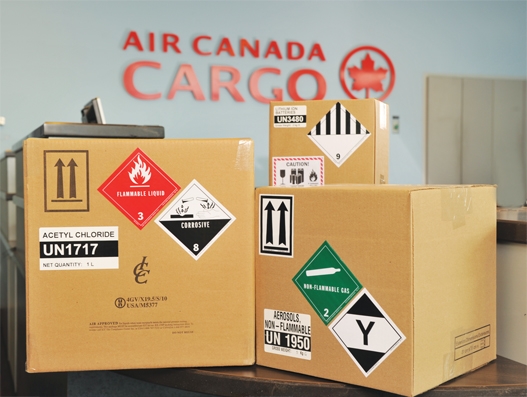
FROM MAGAZINE: Flying hazardous goods
IATA has drawn out strict regulations and guidelines for best practices and compliances for hazardous materials shipments. It gets challenging when shippers fail to adhere to the set rules or follow the steps in the proper handling of items that fall into IATA’s regulated category. The debate surrounding the lithium ion […]

IATA has drawn out strict regulations and guidelines for best practices and compliances for hazardous materials shipments. It gets challenging when shippers fail to adhere to the set rules or follow the steps in the proper handling of items that fall into IATA's regulated category. The debate surrounding the lithium ion batteries and the most recent laptop ban aboard aircraft has increased the burden of complexities in the air cargo industry.
Surya Kannoth
In 2016, global e-commerce giant Amazon was slapped with a fine of £65000 by the UK's Civil Aviation Authority (CAA) for attempting to fly lithium-ion batteries and flammable aerosols. In the same year, a few months earlier, the internet giant was charged a penalty of $350,000 by the US Federal Aviation Administration (FAA) for shipping a corrosive chemical by air thus violating federal law. This was the 25th time that the company was found to violate hazardous chemical shipping regulations over the last two and a half years.
The FAA ruled that the shipment wasn't packaged properly, wasn't accompanied by a declaration of dangerous goods, and was not properly marked or labelled as a hazardous shipment. Such rogue practices of shipping misdeclared dangerous goods have been a critical area of concern for the air cargo industry.
And this practice is not just limited to Amazon; with the growth of e-commerce, the industry has been witnessing an increase in the mislabeling of batteries and in non-declared shipments – in particular from e-commerce sites which use normal/standard mail services.
"There needs to be a greater understanding of what people can send, but also more vigilance from the airlines to make sure they screen goods appropriately to ensure "hidden" dangerous goods (DG) doesn't fly undeclared," shares Rob Flood, manager – business development, Air Canada Cargo.
What is also required is proper training of acceptance staff at stations, knowledge of what DG shipments must be segregated from other DG shipments, limits of Dry Ice per flight, limits of radioactive material per flight – these remain key to handling dangerous goods safely.
The constant changing of regulations set out by ICAO/IATA, and the many governmental and regulatory agencies are, by far, the greatest challenge that airlines are currently facing, blamed Flood. "We often see that shippers are not filling out the Shippers Declaration of Dangerous Goods (DGD) properly, or use improper packaging for their DG shipment (correct packing regulations are set out by ICAO) – they are also challenged with keeping up with all the changes," he added.
However, Dave Brennan, IATA insists that the regulations contain very clearly defined requirements that set out the classification criteria for the different classes of dangerous goods. "These classification criteria are harmonised across all of the different model regulations to facilitate multi-modal transport," he said.
"There are significant quantities of dangerous goods that are offered for sale through e-commerce sites globally. Many of the sellers of these products are unaware that what they are selling are dangerous goods. Examples of this are that there are 10s of thousands of lithium batteries that are offered for sale on e-commerce sites and in many cases, they will offer to the mail to get their products their buyers, despite dangerous goods being forbidden in international air mail," he added.
Recounting a fatal accident that occurred 21 years ago, where non-compliance with dangerous goods regulations led to the loss of 110 lives, Brennan gives details. The ValuJet accident that took place on 11 May 1996 was an accident that resulted from the improper shipment of time expired chemical oxygen generators that caught fire inside a ValuJet DC-9 aircraft flying from Miami to Atlanta. The fire burned through aircraft's control cables; the aircraft crashed into the Everglades killing all 110 passengers and crew.
"The accident investigation identified that the people who packed and shipped the oxygen generators had not been provided with dangerous goods training. The generators were not properly packed, marked or labelled and there was no dangerous goods declaration. In short, this was a total failure to follow any part of the dangerous goods regulations that cost 110 people their lives," Brennan revealed.
Brennan believes that regulators need to put more effort in oversight and surveillance of shippers, in particular, those offering dangerous goods through e-commerce sites. "There also needs to be better coordination and cooperation between regulators in different countries to ensure that dangerous goods incidents that are reported by airlines are properly addressed, and where the necessary action was taken against those shippers who fail to comply with the dangerous goods regulations," he asserts.
The lithium-ion battery threat
Perhaps no other product has given the air cargo industry shudders than lithium metal and ion batteries because of its vulnerability to deadly catastrophes from undeclared hazardous materials. Among the most recent instances is the Samsung Galaxy Note 7 smartphone where its batteries are prone to overheat, and taking a step further, catching fire.
Given the dangers of flying with such phones, the US Department of Transportation in cooperation with other regulatory authorities worldwide banned the Samsung Note 7 models from air travel as well as air cargo after nearly 100 reports of the devices overheating and sometimes injuring owners. Taking note of the situation, the manufacturer stalled the production of the device after updated versions continued to overheat, following a recall of the first version.
Most people think shipping a smartphone with a lithium battery is no big deal, but there is a risk associated with that LI battery, and it needs to be declared and handled appropriately," Air Canada Cargo's Flood emphasises.
Donald Trump's Yorker: The laptop ban
While the safety concerns related to lithium-ion batteries continues to loom, the Trump administration recently banned laptops in the cabin of some flights from the Middle East and Africa. This has further sparked concerns about the risk of fires from lithium-ion batteries stored in cargo.
According to a report released by FAA in 2015, "the uncontrollability of lithium battery fires can ultimately negate the capability of current aircraft cargo fire suppression systems, and can lead to a catastrophic failure of the airframe."
Aviation experts worry about how lithium batteries are stored because they can produce fires that are tough to put out with on-board fire extinguishers. There has been evidence of risks associated with the storage of lithium batteries. Two Boeing 747 crashes — a UPS freighter in 2010 and an Asiana Cargo plane in 2011 — happened after fires broke out in the cargo holds.
The UPS cargo plane that crashed in Dubai in 2010 contained several large, undeclared lithium ion batteries which originated from China. Shortly after this accident, in July 2011, an in-flight fire and crash of an Asiana Airlines plane in international waters off South Korea. Investigators found out that the cause of the accident was a fire that developed around two pallets containing dangerous goods packages, including hybrid-electric vehicle lithium ion batteries and flammable liquids. They could not find a definitive cause of the fire but said the proximity of the flammable materials and the lithium ion batteries in the plane's hold was a contributing factor in the fire's spread.
The International Civil Aviation Organization (ICAO) had earlier advised global regulators to ban carrying bulk shipments of such batteries in the cargo holds of passenger jets. It needs to be seen how the aviation industry deals with this all-out ban – an immensely complex issue since the ban on liquids was introduced.
Road ahead
While cargo carriers agree that safe shipment of products classified as dangerous goods largely depends on the involvement of shippers and buyers, the long-term solution lies in stricter enforcement of existing rules, and greater diligence is needed by regulators.
Photo Source: Air Canada Cargo

